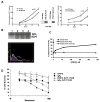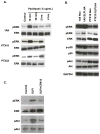Secretory leukocyte protease inhibitor antagonizes paclitaxel in ovarian cancer cells
- PMID: 20068074
- PMCID: PMC2808000
- DOI: 10.1158/1078-0432.CCR-09-1979
Secretory leukocyte protease inhibitor antagonizes paclitaxel in ovarian cancer cells
Abstract
Purpose: Ovarian cancer recurrence with the development of paclitaxel resistance is an obstacle to long-term survival. We showed that secretory leukocyte protease inhibitor (SLPI) is a survival factor for ovarian cancer. We hypothesize that SLPI may antagonize paclitaxel injury.
Experimental design: Differential SLPI induction in response to paclitaxel and in response to stable forced expression of SLPI was shown in A2780-1A9 cells and their paclitaxel-resistant sublines, PTX10 and PTX22, and confirmed with HEY-A8 cells. SLPI-mediated survival was reduced by the MAP/extracellular signal-regulated kinase (ERK) kinase inhibitor, U0126, and a humanized neutralizing monoclonal anti-SLPI antibody, CR012. OVCAR3 xenographs tested the role of CR012 in vivo.
Results: SLPI expression was lower in A2780-1A9 ovarian cancer cells than in PTX10 and PTX22, and SLPI was induced by paclitaxel exposure. Stable SLPI expression yielded a proliferation advantage (P = 0.01); expression of and response to SLPI in OVCAR3 cells were abrogated by exposure to CR012. SLPI reduced the paclitaxel susceptibility of 1A9 and HEY-A8 cells (P <or= 0.05), and SLPI expression did not increase the resistance of PTX10 and PTX22 cells. Both paclitaxel and SLPI overexpression induced ERK activation. Inhibition of MAP/ERK kinase with U0126 increased paclitaxel injury and overcame SLPI-mediated cell protection. It did not reinstate PTX10 sensitivity to paclitaxel, which was associated with AKT activation. Significant inhibition of OVCAR3 xenograft growth was observed with CR012 and paclitaxel, over single agents (P <or= 0.001).
Conclusions: A two-pronged approach confirmed that SLPI overcomes paclitaxel in part through activation of ERK1/2. These results credential SLPI as a molecular target for ovarian cancer and suggest CR012 as a tool for proof of concept.
Figures






Similar articles
-
The alarm anti-protease, secretory leukocyte protease inhibitor, is a proliferation and survival factor for ovarian cancer cells.Carcinogenesis. 2008 Mar;29(3):466-72. doi: 10.1093/carcin/bgm212. Epub 2007 Oct 4. Carcinogenesis. 2008. PMID: 17916899
-
Overexpression of protease inhibitor-dead secretory leukocyte protease inhibitor causes more aggressive ovarian cancer in vitro and in vivo.Cancer Sci. 2009 Mar;100(3):434-40. doi: 10.1111/j.1349-7006.2009.01076.x. Epub 2009 Jan 14. Cancer Sci. 2009. PMID: 19154415 Free PMC article.
-
Paclitaxel (Taxol(R)) inhibits motility of paclitaxel-resistant human ovarian carcinoma cells.Clin Cancer Res. 1996 Oct;2(10):1725-30. Clin Cancer Res. 1996. PMID: 9816123
-
Mechanistic analysis of taxol-induced multidrug resistance in an ovarian cancer cell line.Asian Pac J Cancer Prev. 2013;14(9):4983-8. doi: 10.7314/apjcp.2013.14.9.4983. Asian Pac J Cancer Prev. 2013. PMID: 24175763
-
Polo Like Kinase 2 Tumour Suppressor and cancer biomarker: new perspectives on drug sensitivity/resistance in ovarian cancer.Oncotarget. 2012 Jan;3(1):78-83. doi: 10.18632/oncotarget.332. Oncotarget. 2012. PMID: 22289679 Free PMC article. Review.
Cited by
-
FAPhigh α-SMAlow cancer-associated fibroblast-derived SLPI protein encapsulated in extracellular vesicles promotes ovarian cancer development via activation of PI3K/AKT and downstream signaling pathways.Mol Carcinog. 2022 Oct;61(10):910-923. doi: 10.1002/mc.23445. Epub 2022 Jul 8. Mol Carcinog. 2022. PMID: 35801406 Free PMC article.
-
Progranulin is a potential prognostic biomarker in advanced epithelial ovarian cancers.Gynecol Oncol. 2011 Jan;120(1):5-10. doi: 10.1016/j.ygyno.2010.09.006. Epub 2010 Oct 15. Gynecol Oncol. 2011. PMID: 20950846 Free PMC article.
-
Silencing dishevelled-1 sensitizes paclitaxel-resistant human ovarian cancer cells via AKT/GSK-3β/β-catenin signalling.Cell Prolif. 2015 Apr;48(2):249-58. doi: 10.1111/cpr.12161. Epub 2015 Jan 21. Cell Prolif. 2015. PMID: 25643607 Free PMC article.
-
In-depth LC-MS/MS analysis of the chicken ovarian cancer proteome reveals conserved and novel differentially regulated proteins in humans.Anal Bioanal Chem. 2015 Sep;407(22):6851-63. doi: 10.1007/s00216-015-8862-4. Epub 2015 Jul 10. Anal Bioanal Chem. 2015. PMID: 26159569 Free PMC article.
-
Targeting secretory leukocyte protease inhibitor (SLPI) inhibits colorectal cancer cell growth, migration and invasion via downregulation of AKT.PeerJ. 2020 Jul 14;8:e9400. doi: 10.7717/peerj.9400. eCollection 2020. PeerJ. 2020. PMID: 32742768 Free PMC article.
References
-
- Jemal A, Siegel R, Ward E, et al. Cancer statistics. CA: a cancer journal for clinicians. 2008;58:71–96. - PubMed
-
- Einzig AI, Wiernik PH, Sasloff J, Runowicz CD, Goldberg GL. Phase II study and long-term follow-up of patients treated with taxol for advanced ovarian adenocarcinoma. J Clin Oncol. 1992;10:1748–53. - PubMed
-
- du Bois A, Luck HJ, Meier W, et al. A randomized clinical trial of cisplatin/paclitaxel versus carboplatin/paclitaxel as first-line treatment of ovarian cancer. J Natl Cancer Inst. 2003;95:1320–9. - PubMed
-
- Agarwal R, Kaye SB. Ovarian cancer: strategies for overcoming resistance to chemotherapy. Nat Rev Cancer. 2003;3:502–16. - PubMed
-
- Hough CD, Cho KR, Zonderman AB, Schwartz DR, Morin PJ. Coordinately up-regulated genes in ovarian cancer. Cancer Res. 2001;61:3869–76. - PubMed
Publication types
MeSH terms
Substances
Grants and funding
LinkOut - more resources
Full Text Sources
Other Literature Sources
Medical
Miscellaneous

